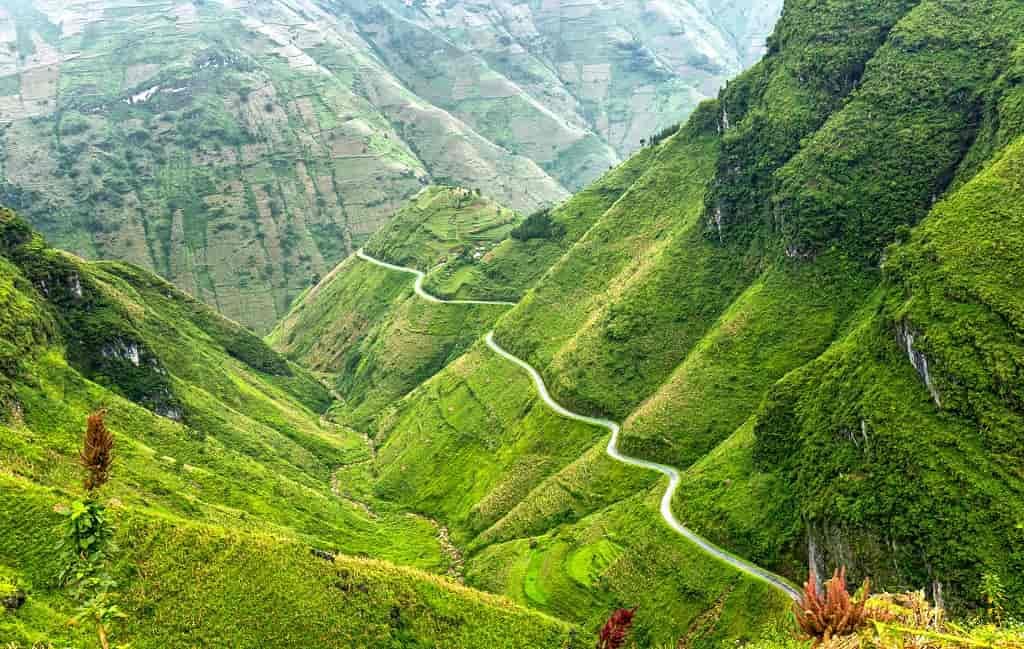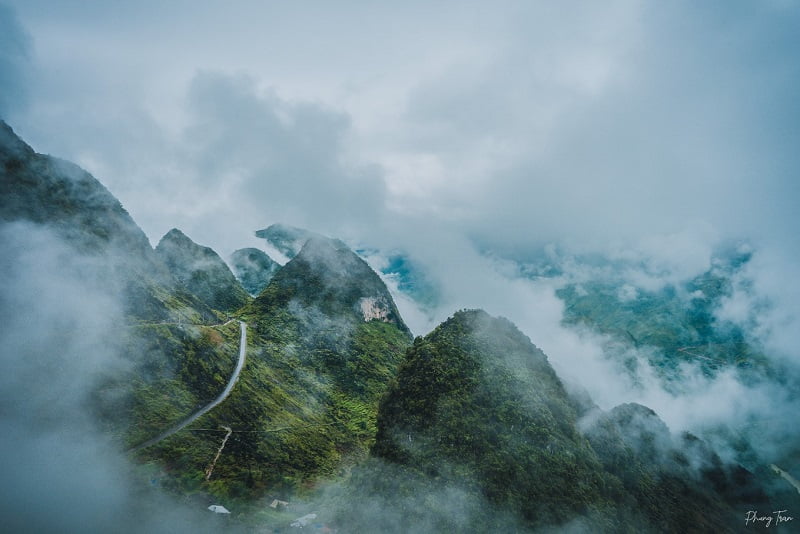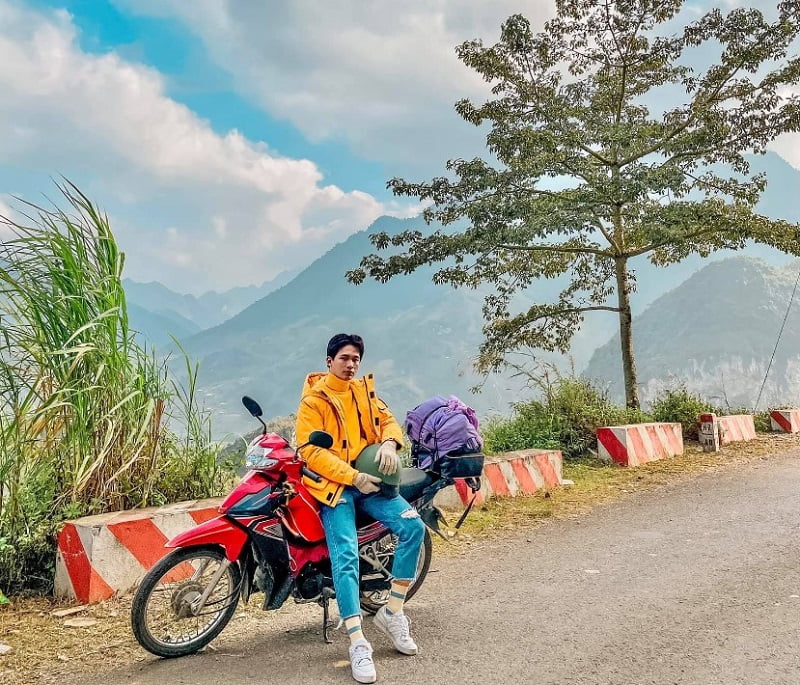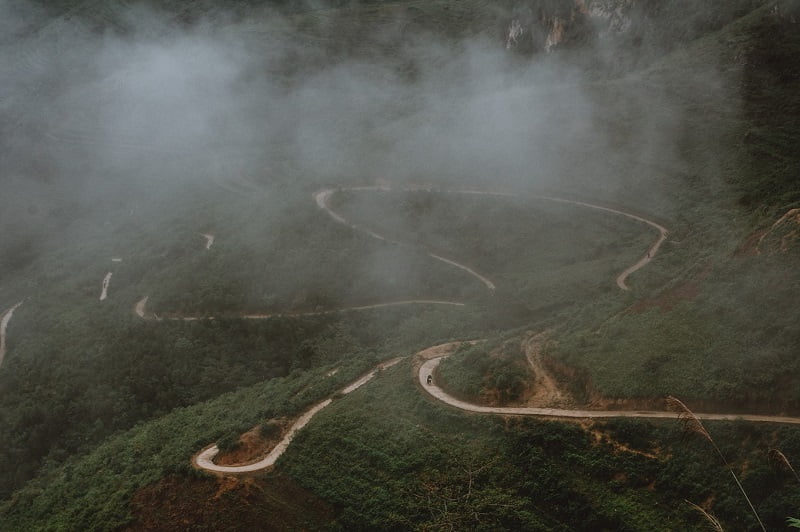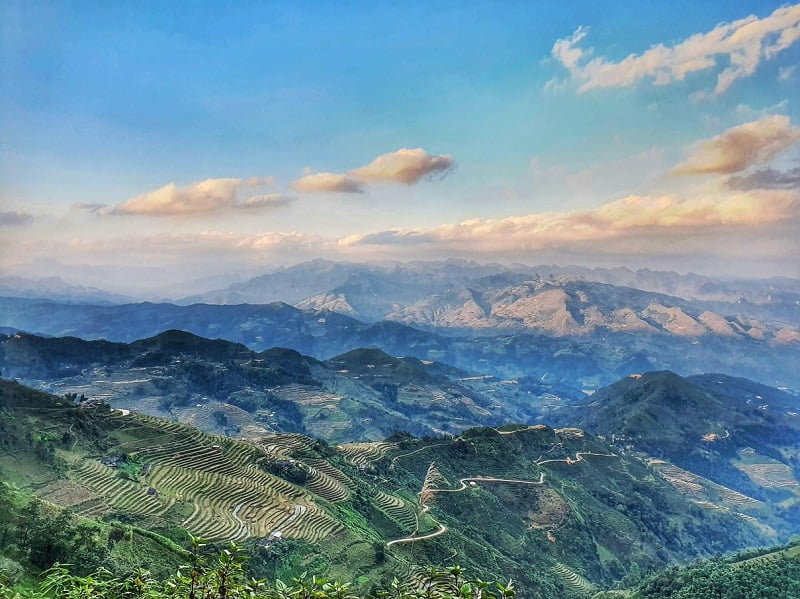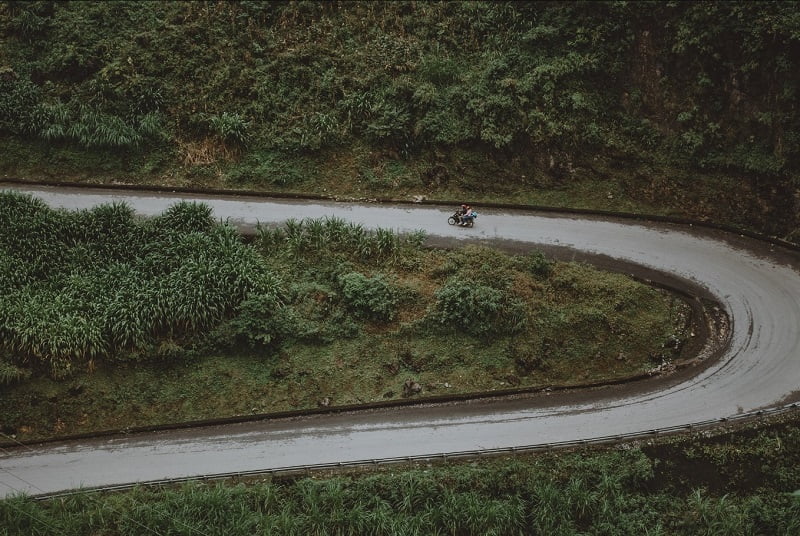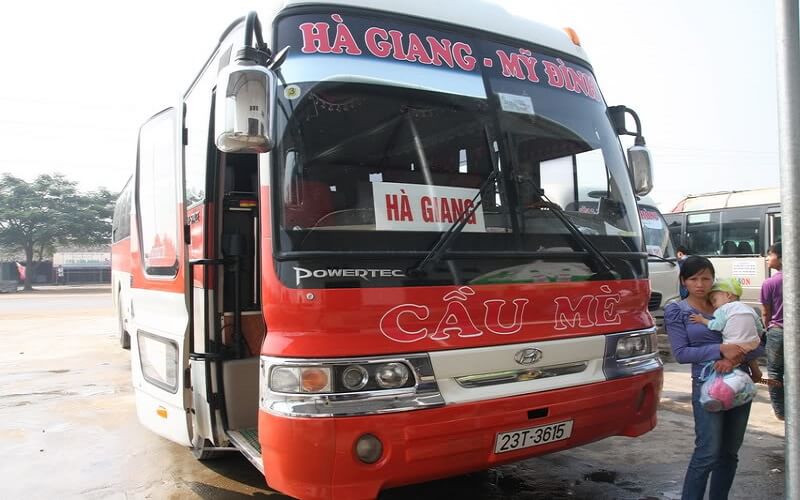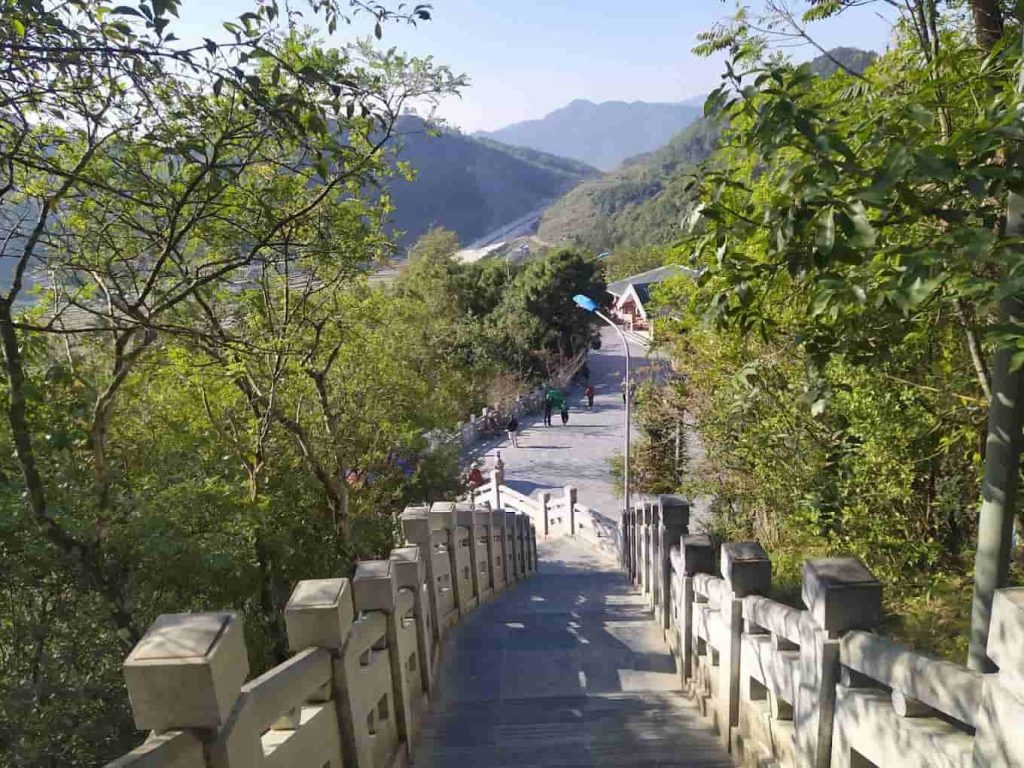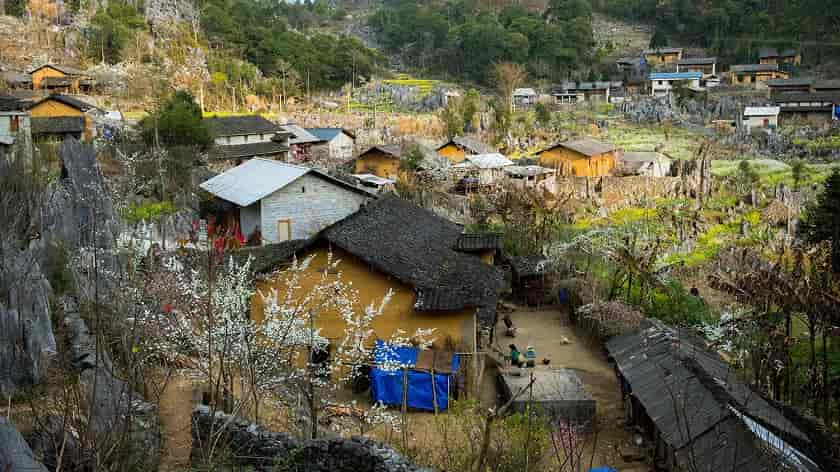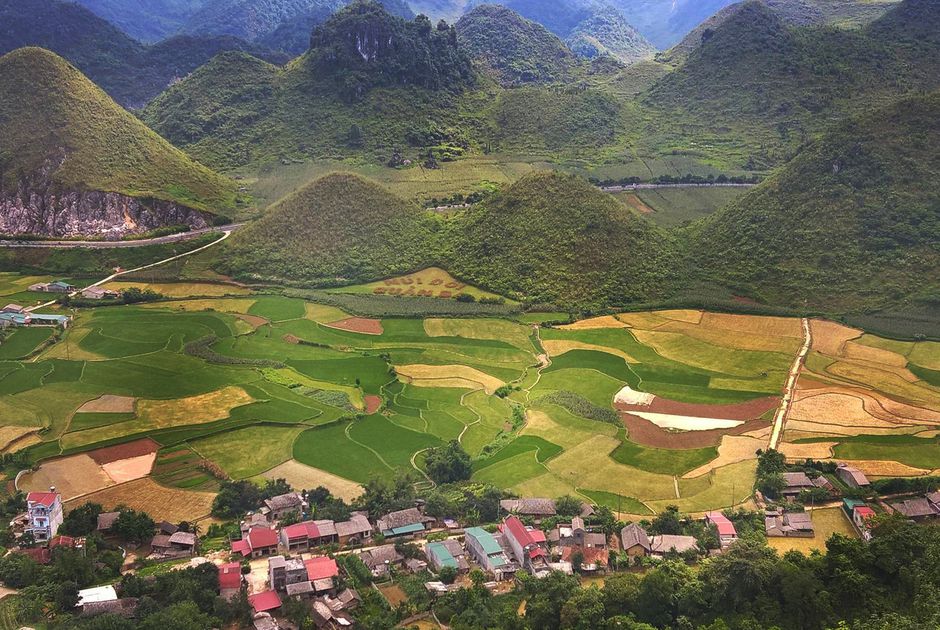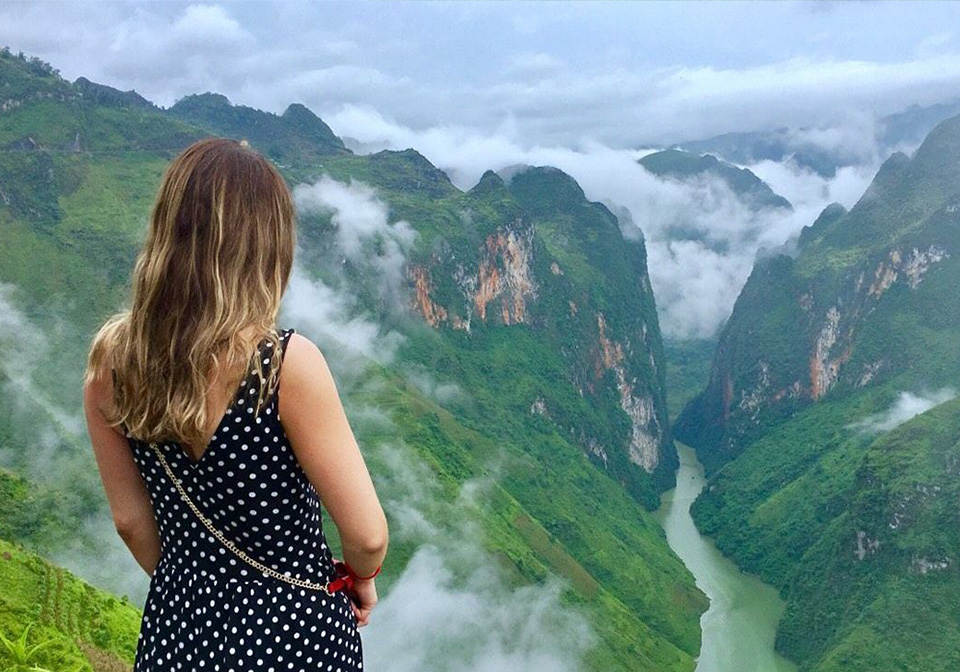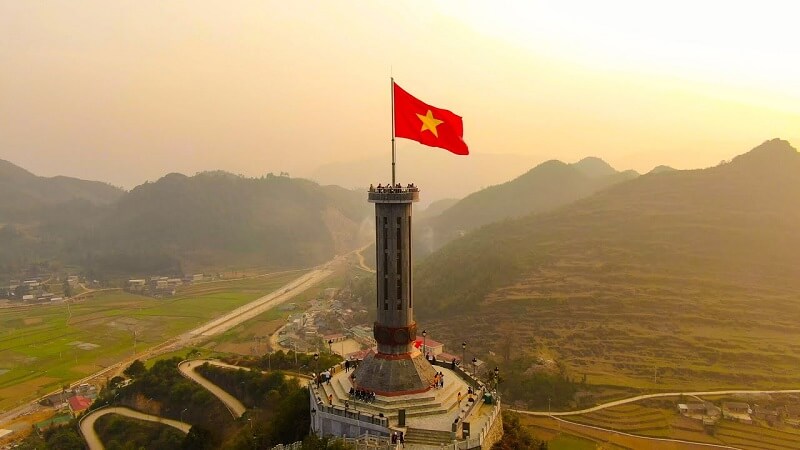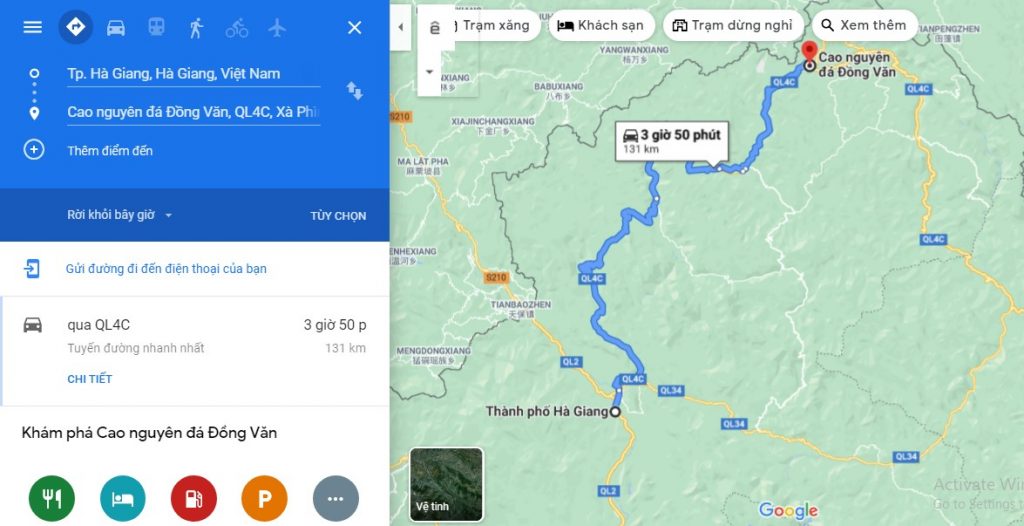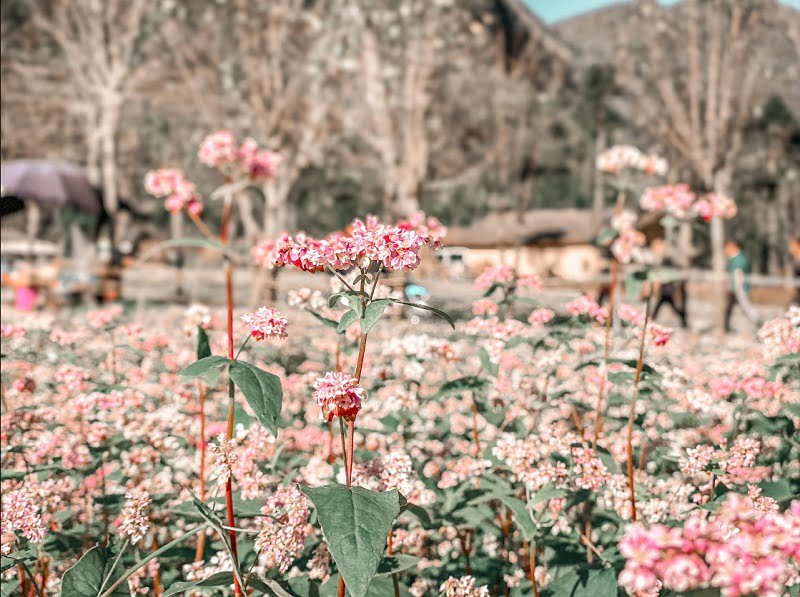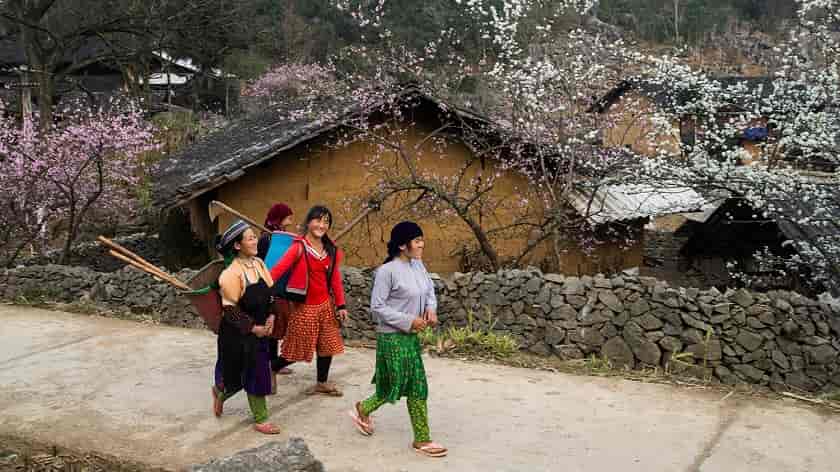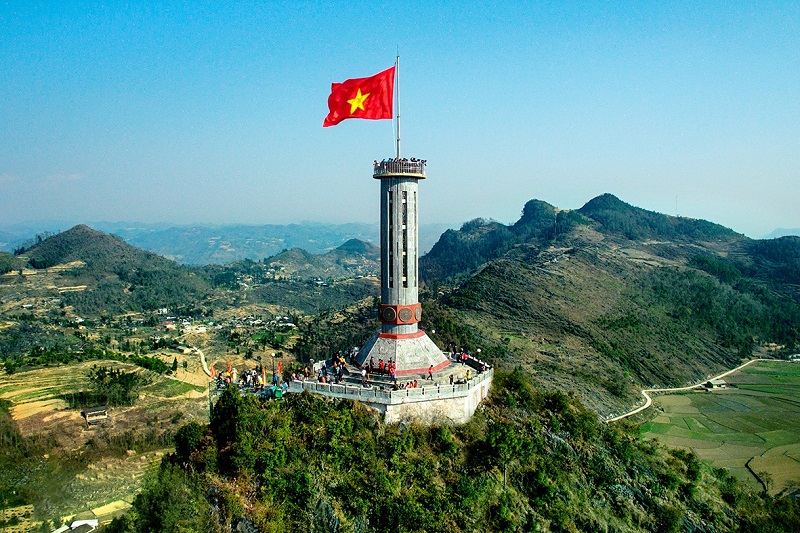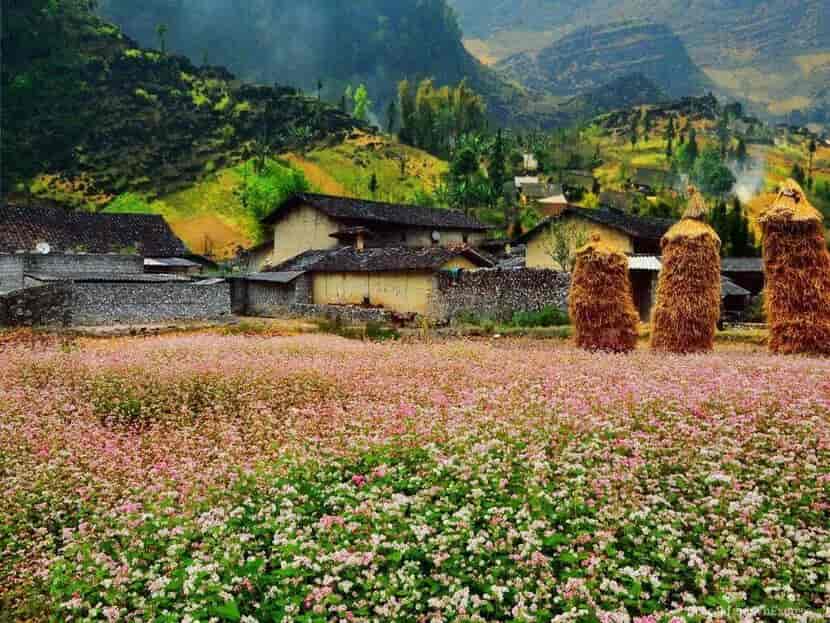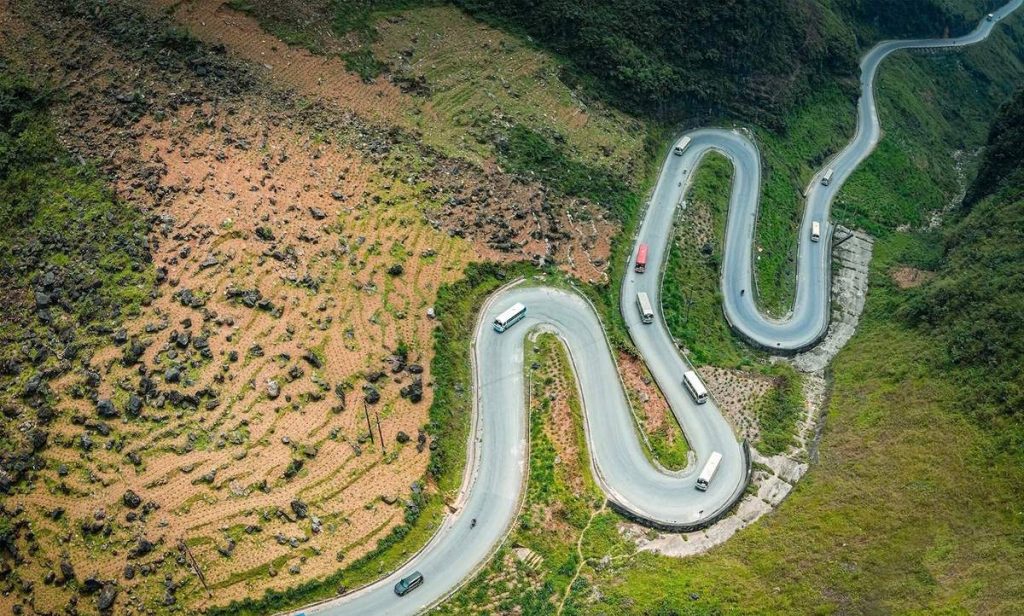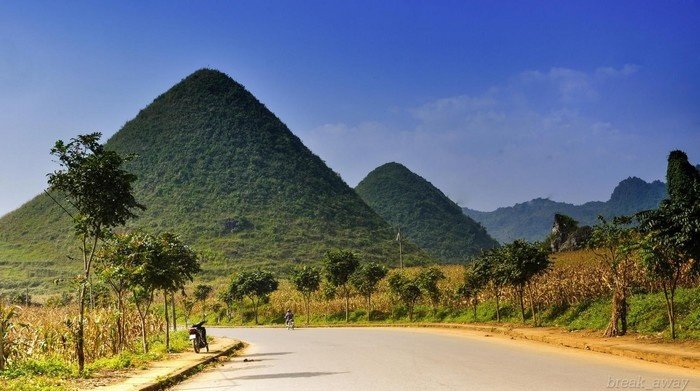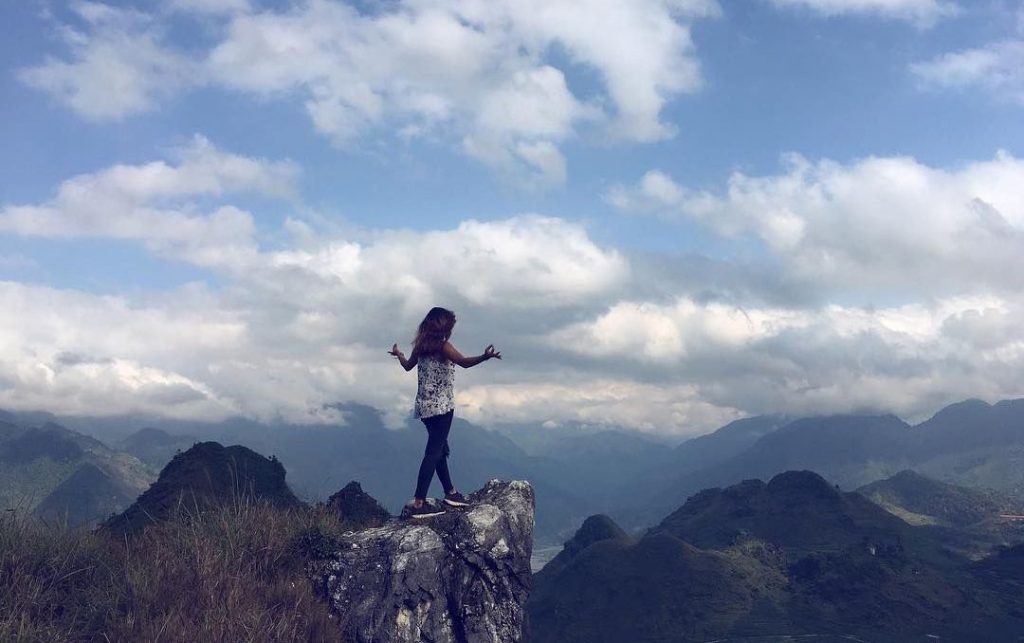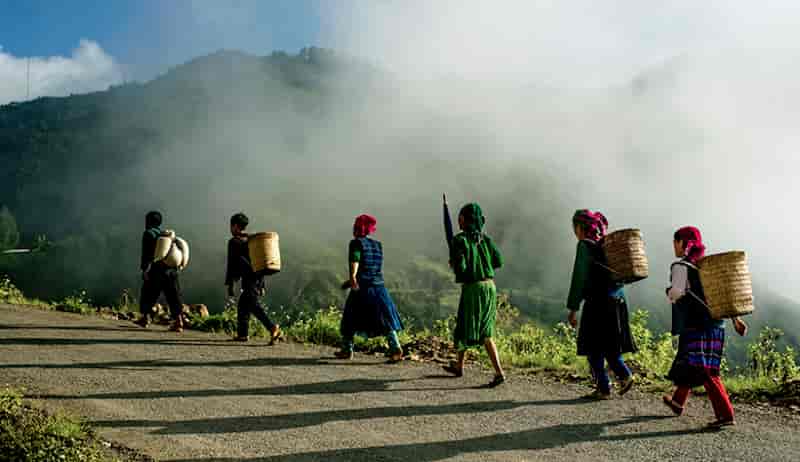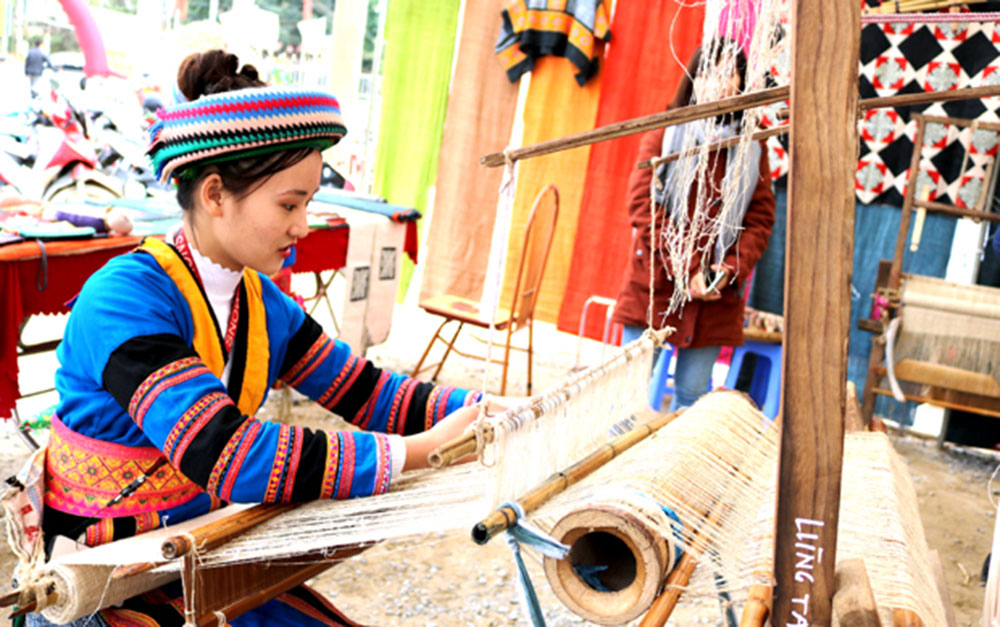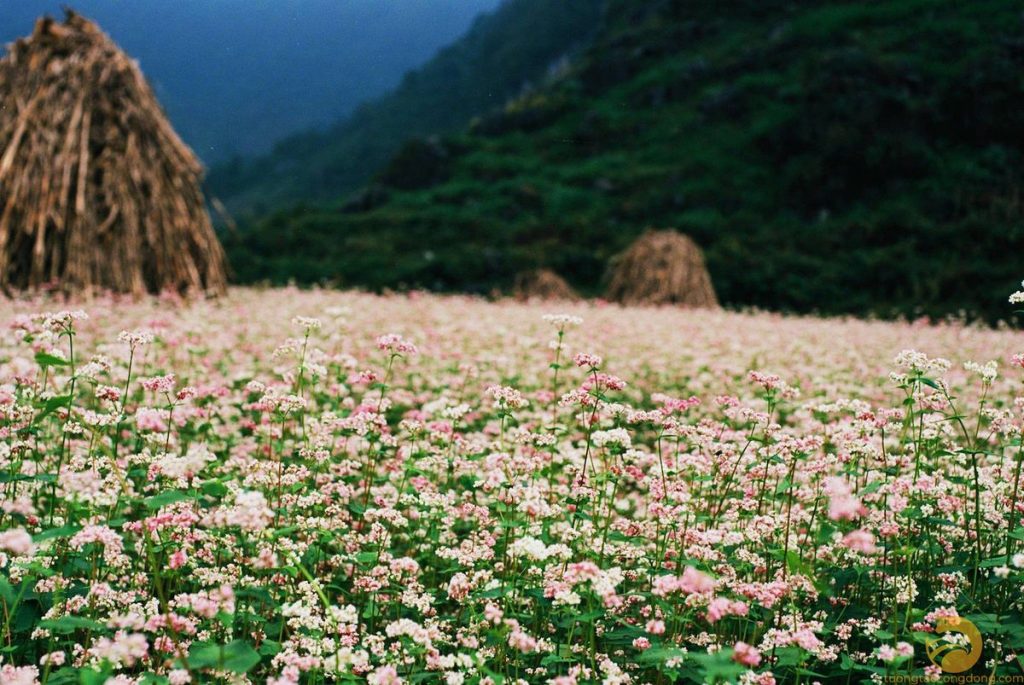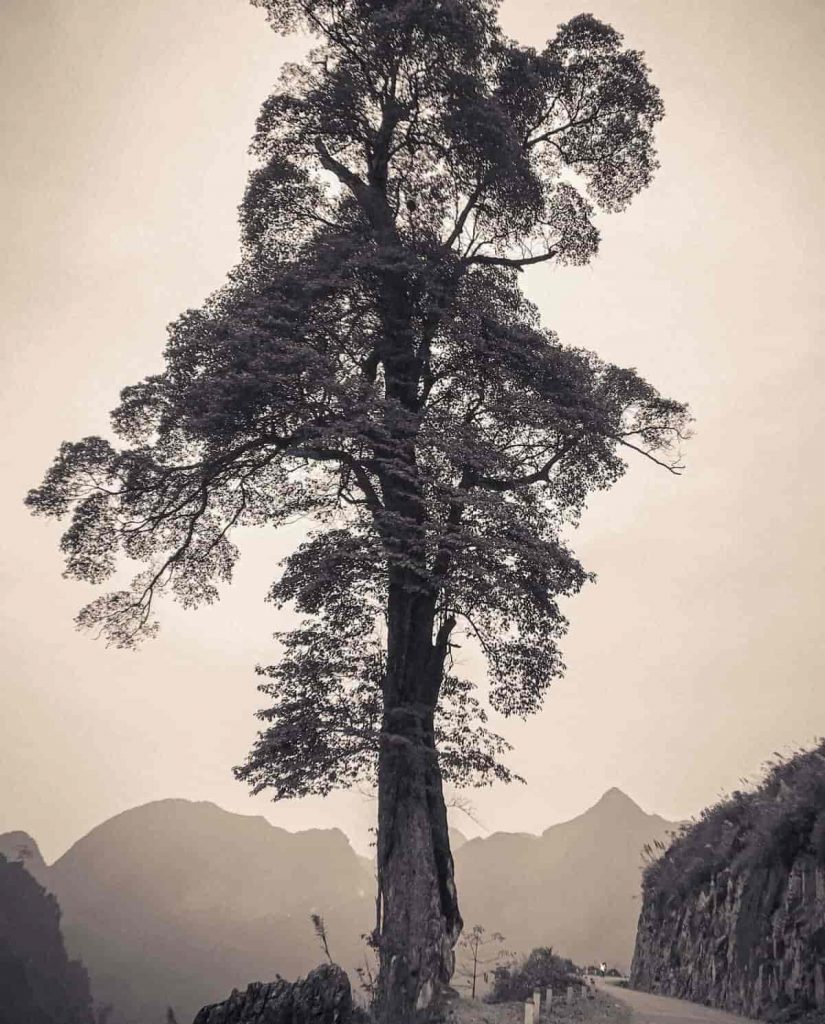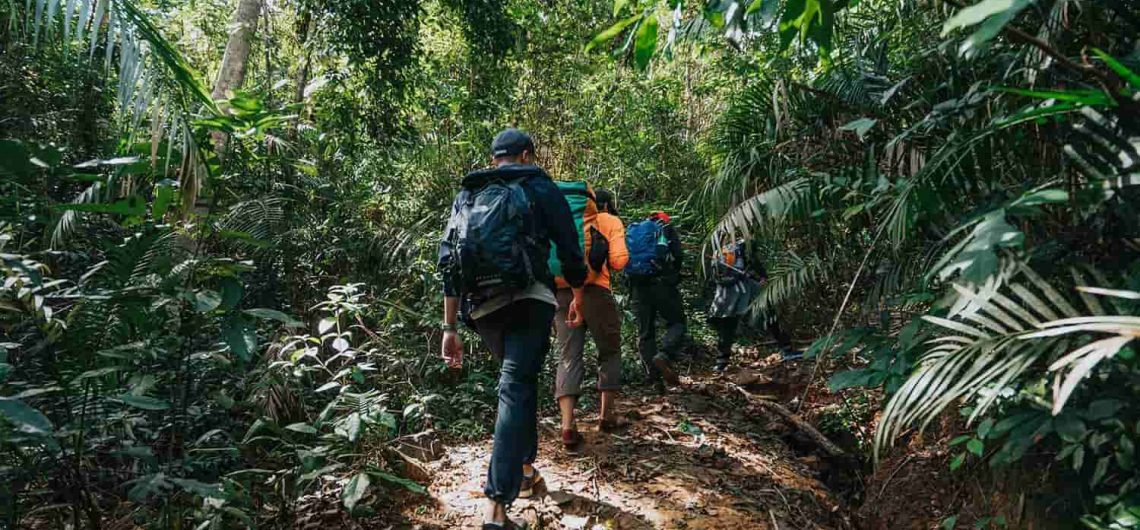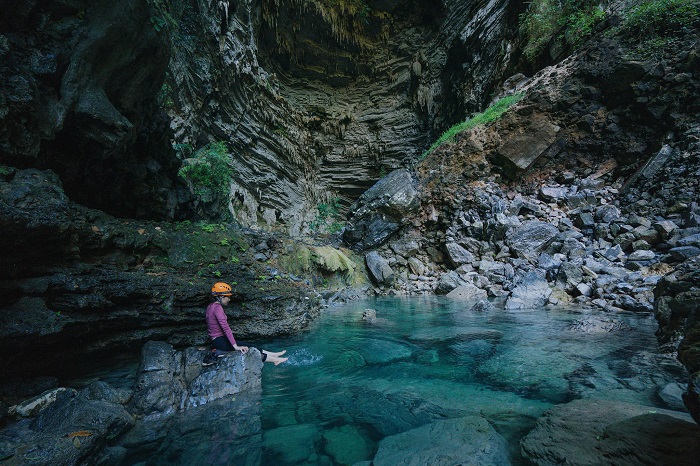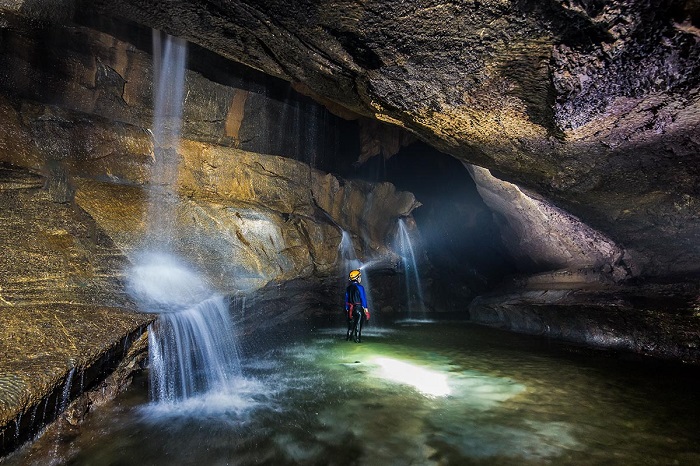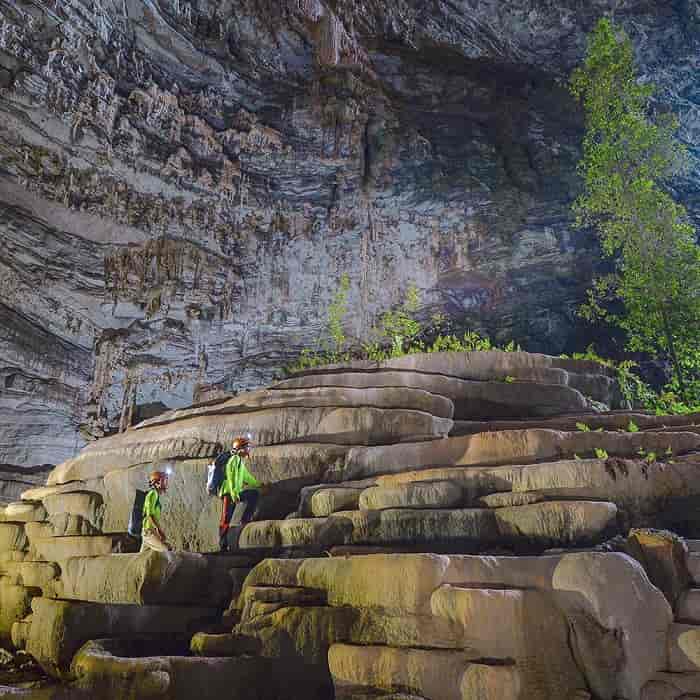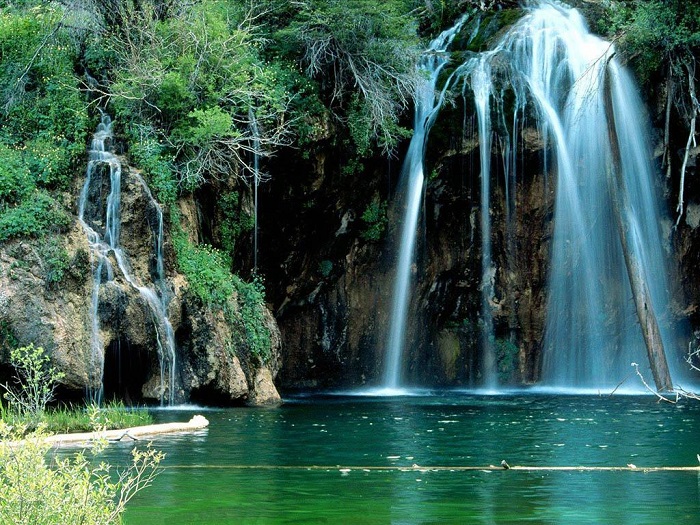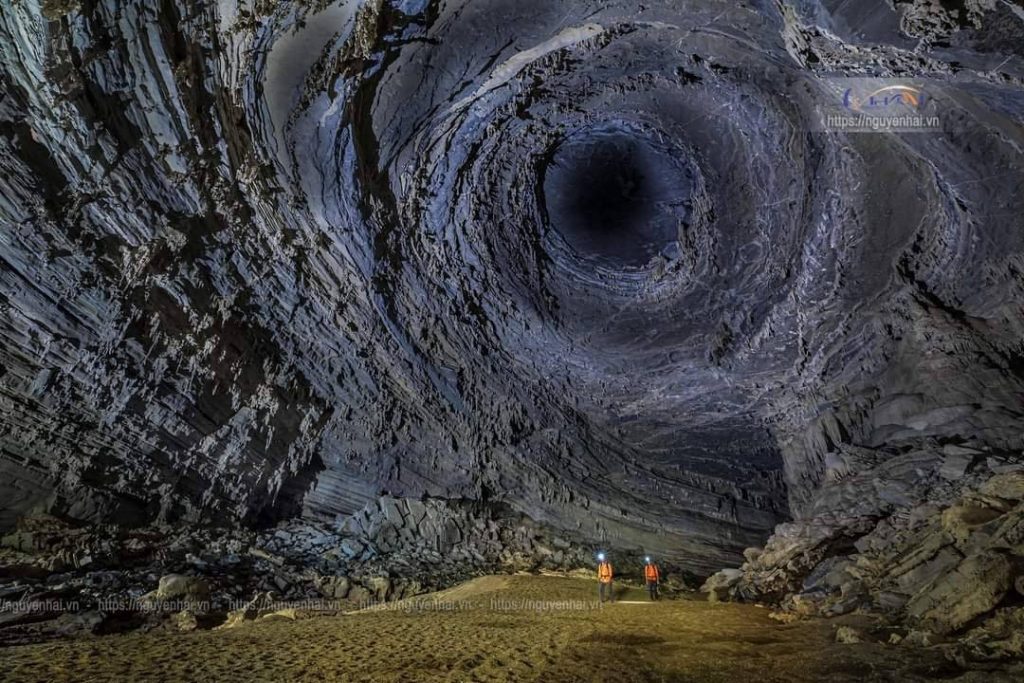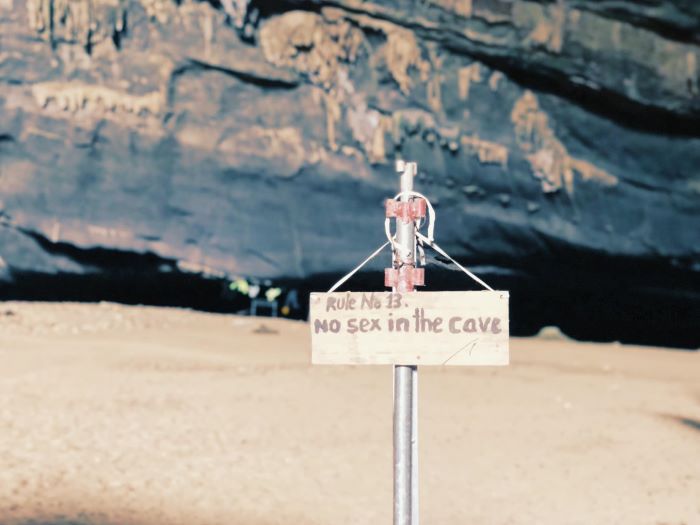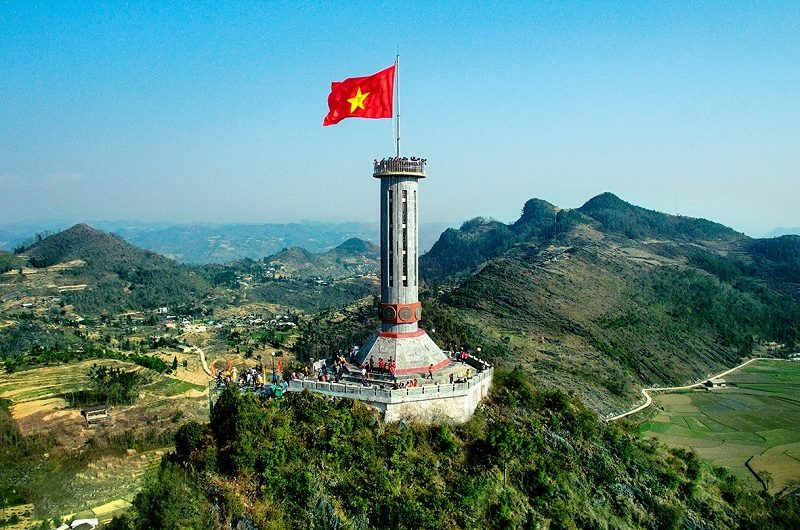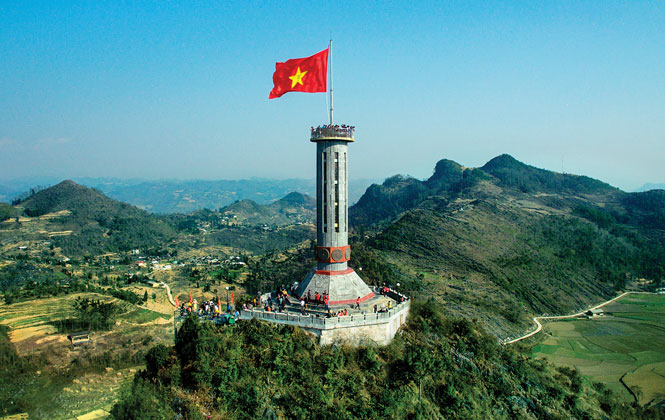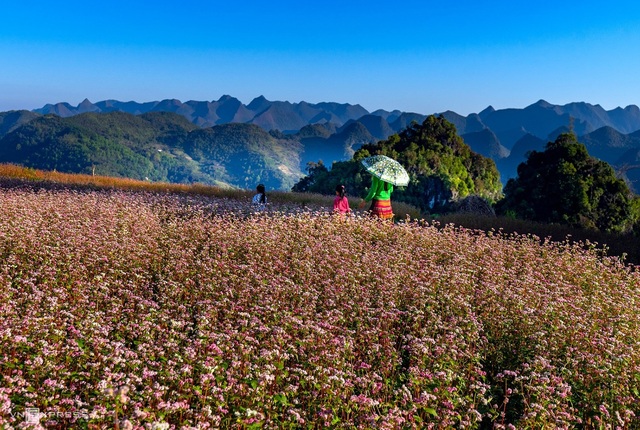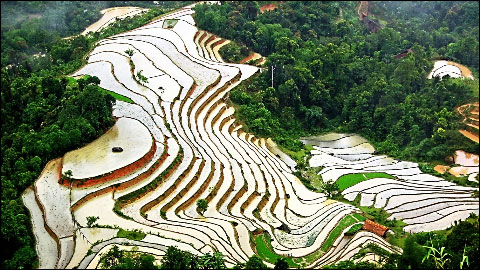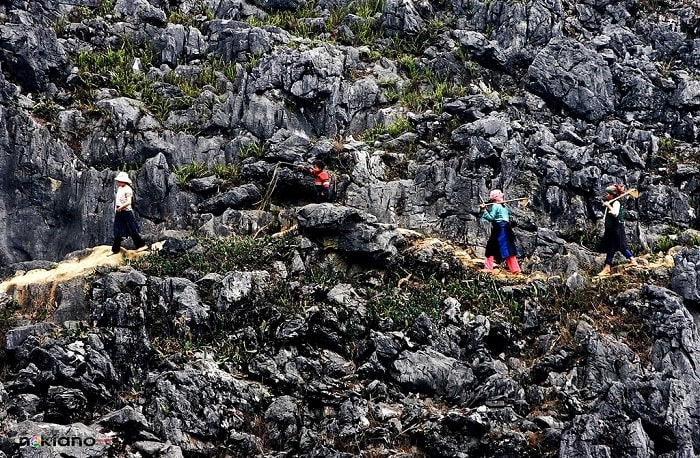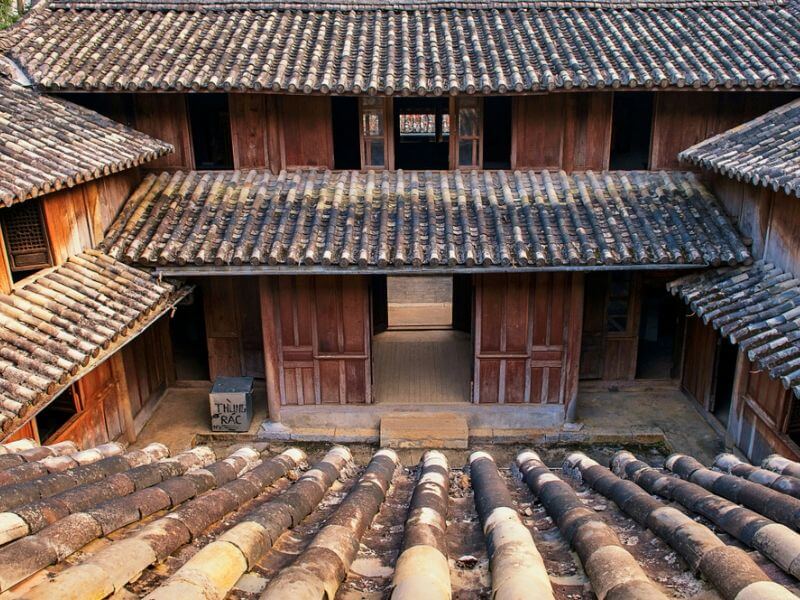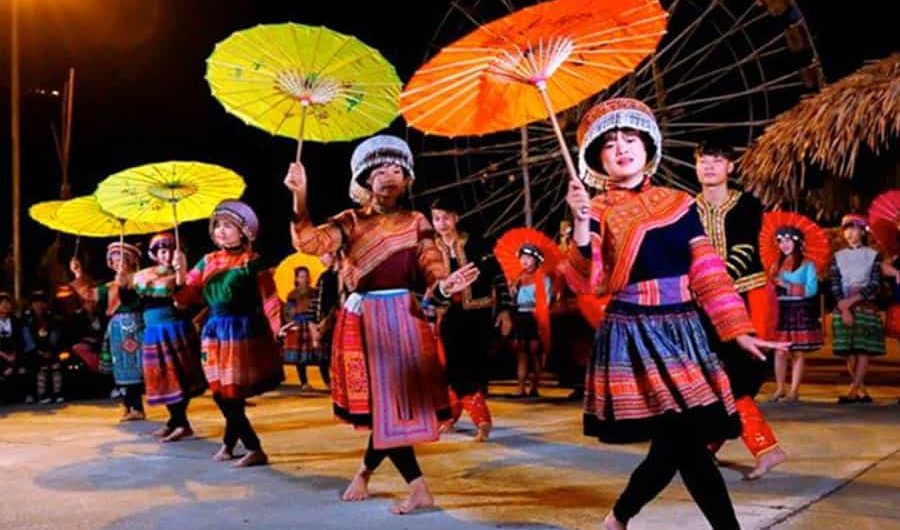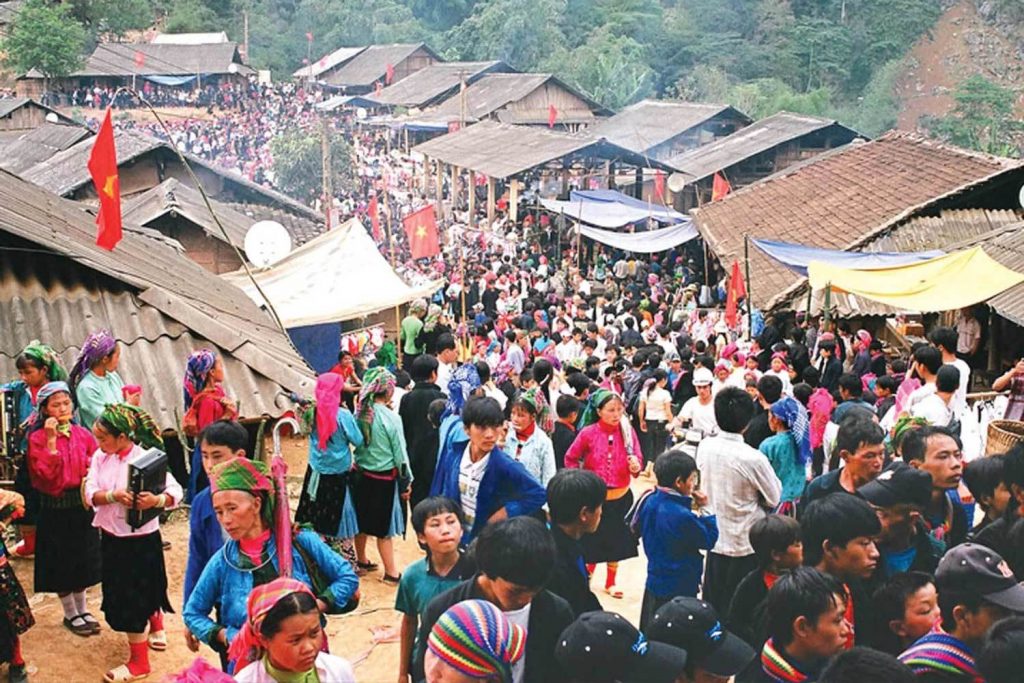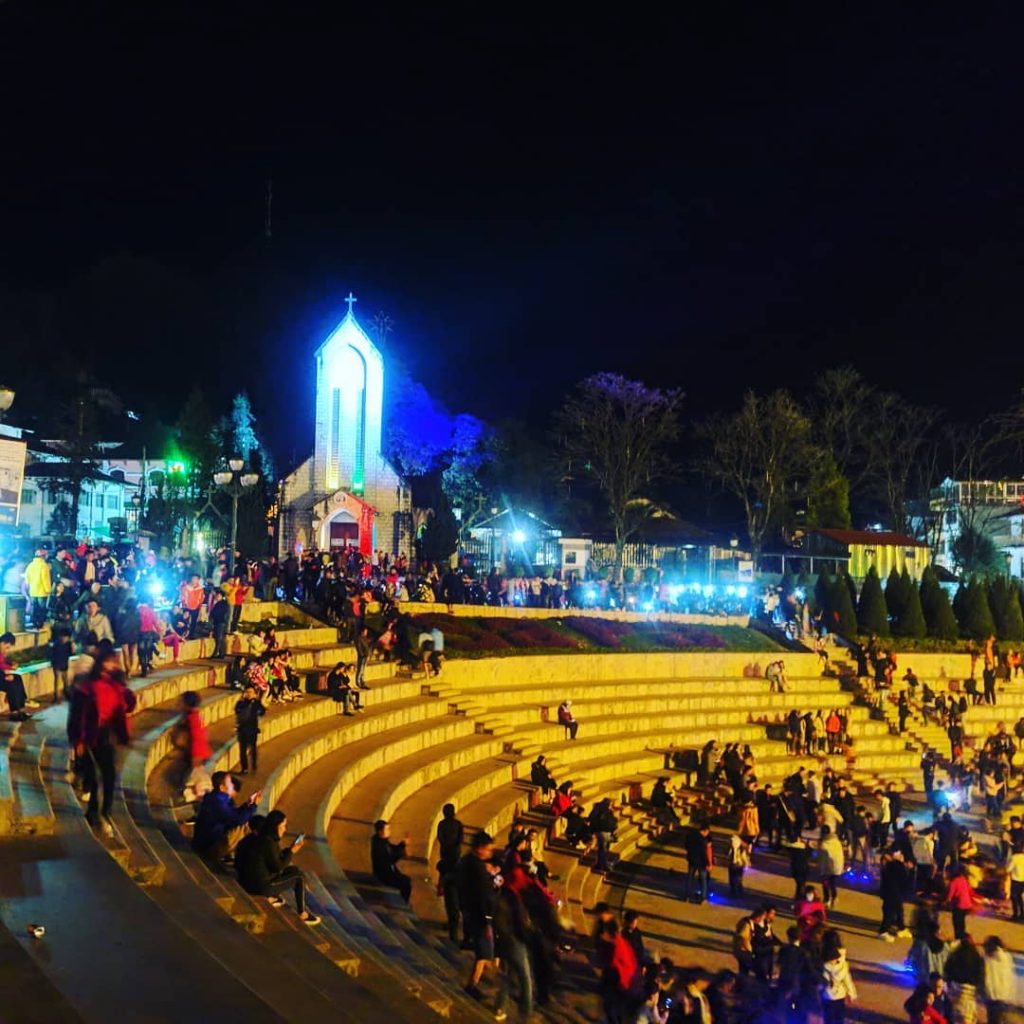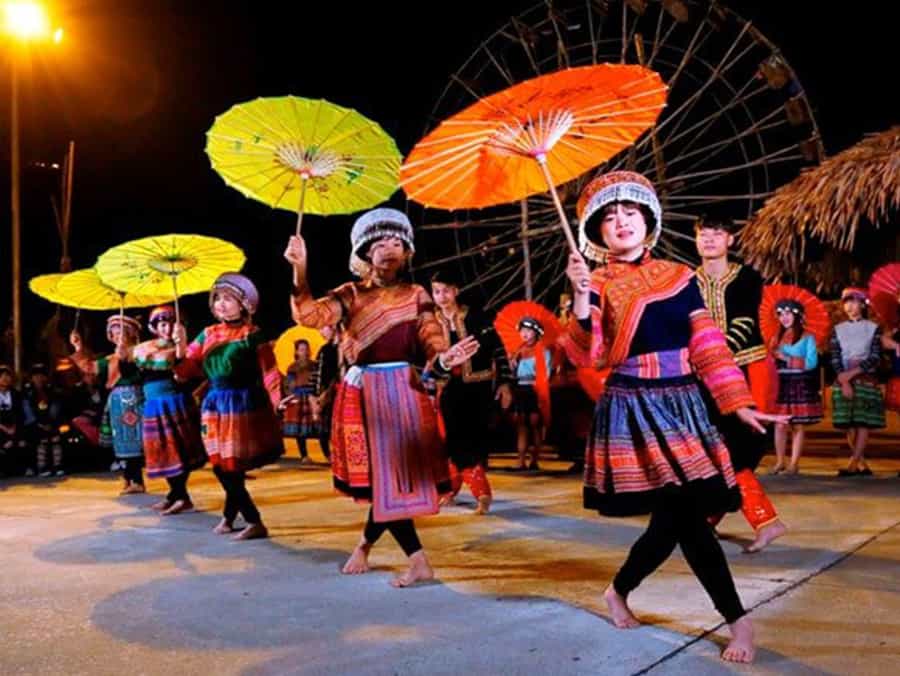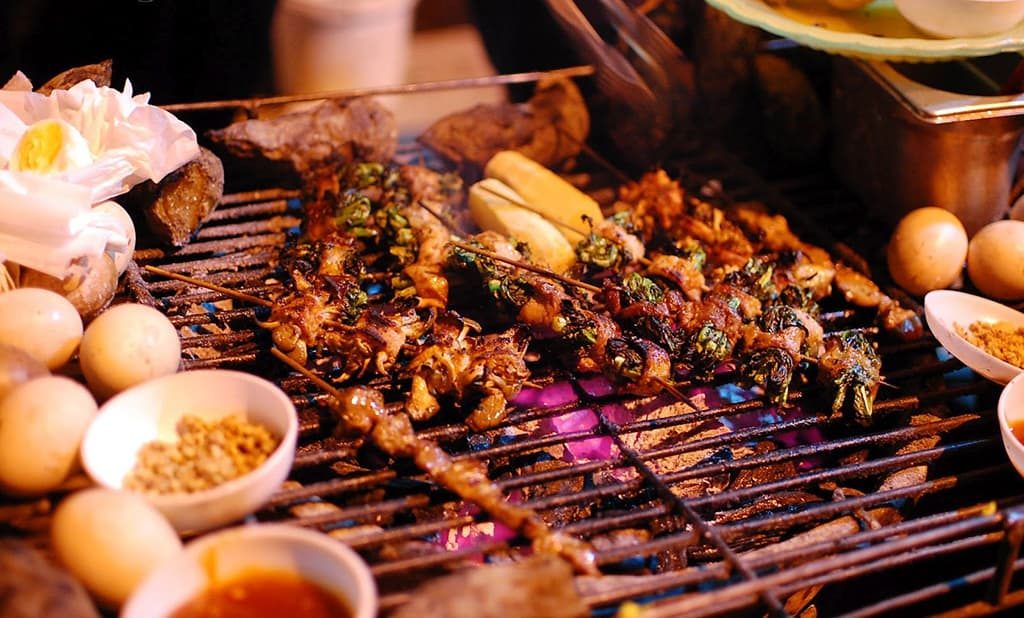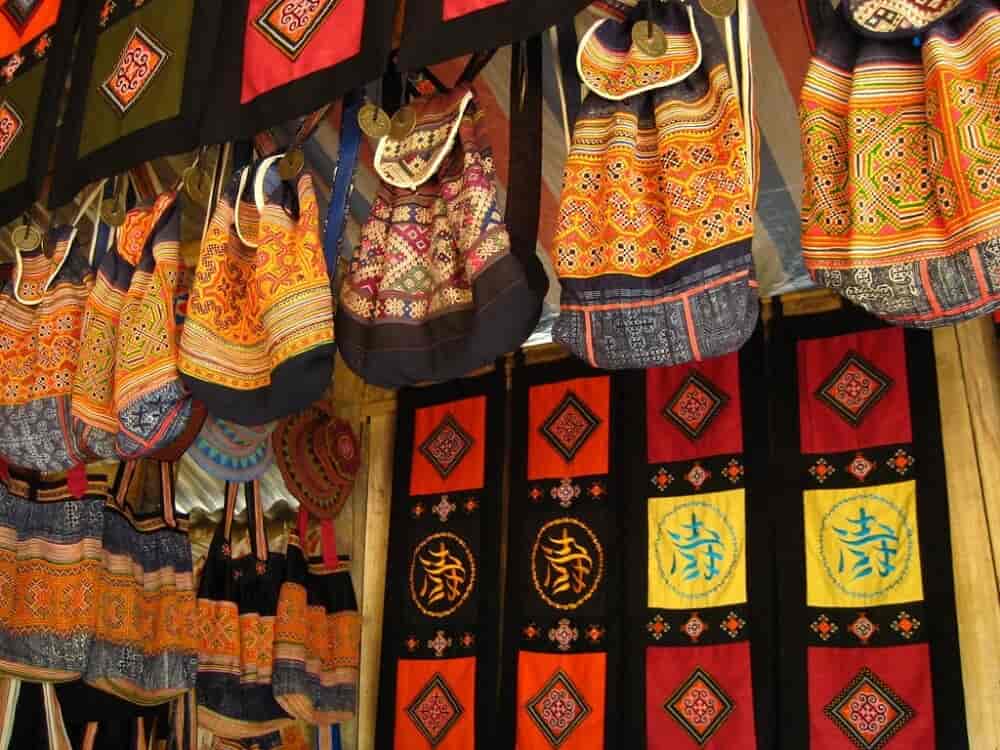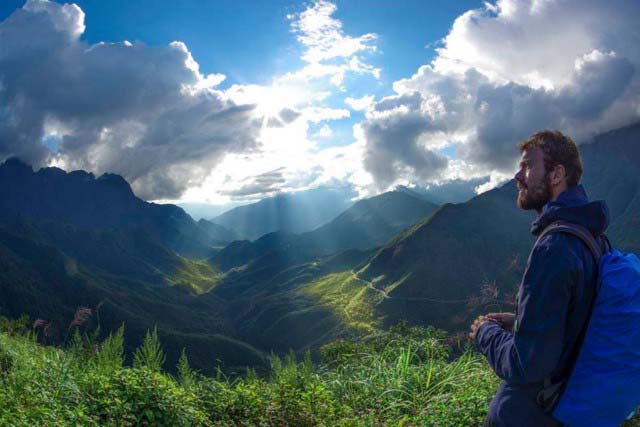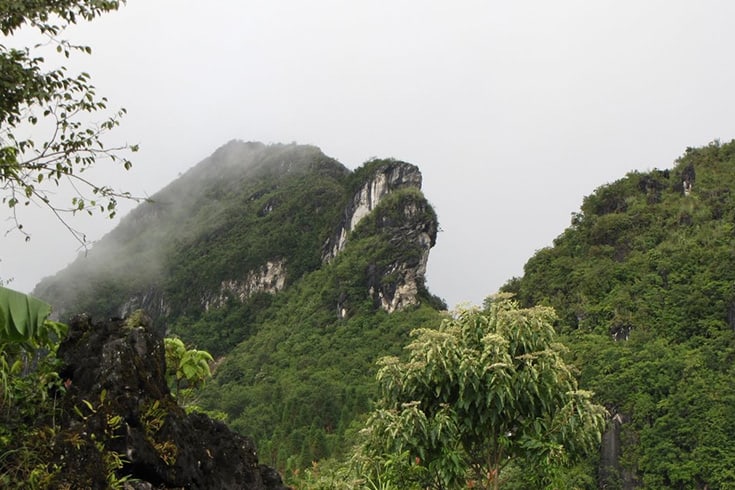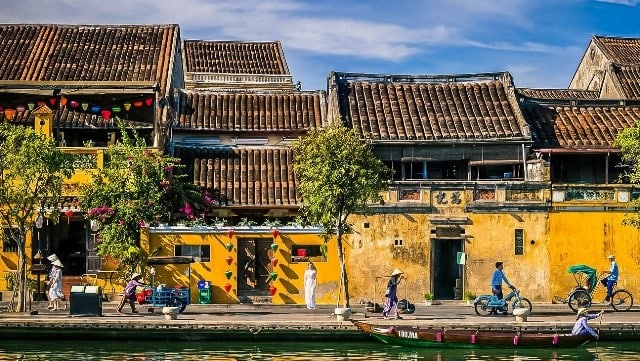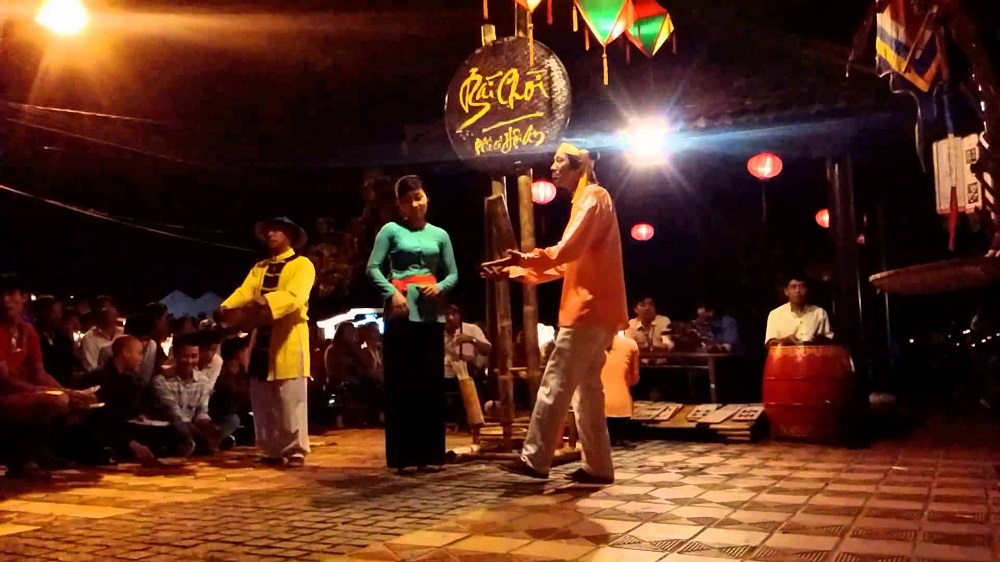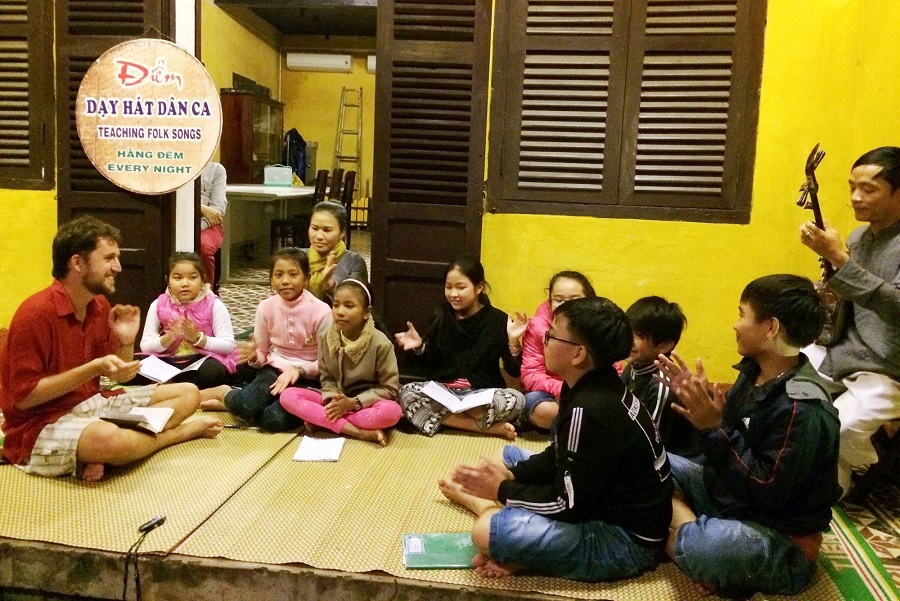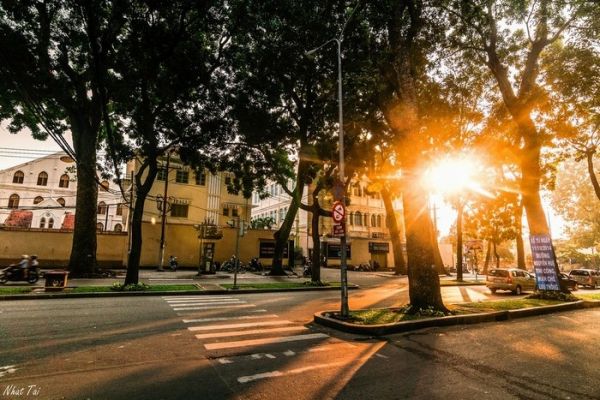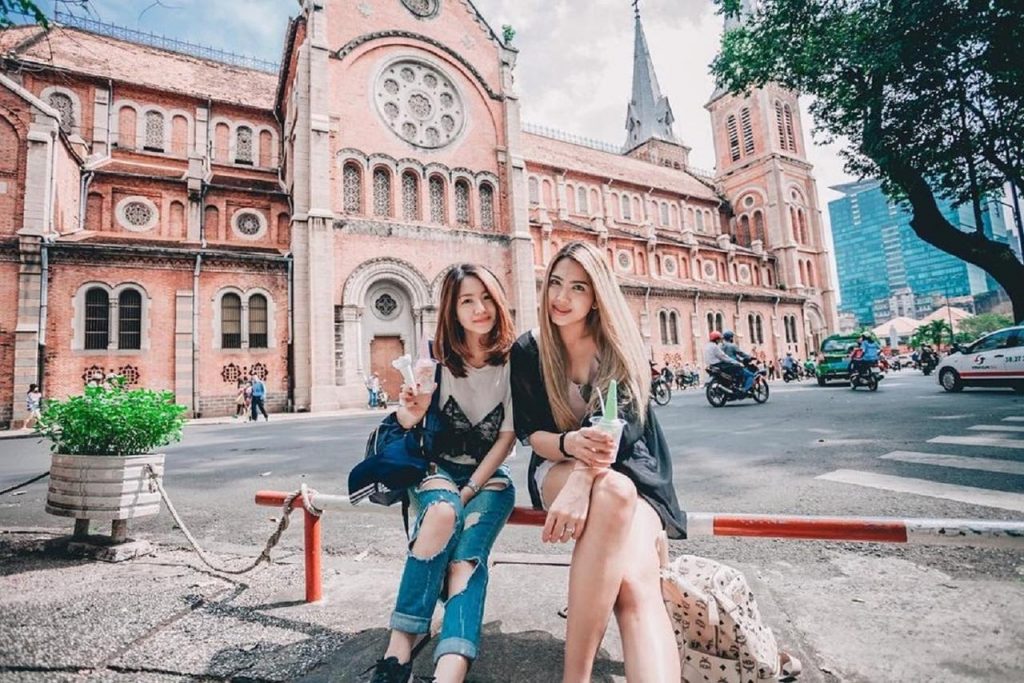Ha Giang is not only known for its stunning landscapes, steep passes, and beautiful scenery, but it is also celebrated for its diverse and rich culinary traditions. Join DanangPrivateCar.com’s on a journey to explore the top 15 delicious dishes you must try when you visit Ha Giang.
Dong Van Rolled Rice Pancakes
When talking about delicious dishes in Ha Giang, Dong Van Rolled Rice Pancakes should not be missed. At first glance, one might think that rice pancakes everywhere are the same and nothing special. However, when you take a bite, you will truly appreciate the unique flavors this dish offers. In other regions, rice pancakes are often served with fish sauce, lime, and chili, but in Ha Giang, they are served with a rich bone broth, complemented with thinly sliced scallions and fragrant coriander leaves that blend with the rich, velvety taste of the bone broth. Many people might find this way of eating quite different, but once you try it, you’ll be hooked. The rice pancakes come with two filling options: crispy fragrant plain rice pancakes or ones with shredded pork and minced meat.

When eating rice pancakes, you can add a few slices of sausage, cut them in half, or leave them whole in a bowl of bone soup. In addition to the white rice pancakes, there is another type called “yellow rice pancakes” which are made from steamed rice flour. These pancakes, which look visually appealing with a golden color, are served hot and sprinkled with dried shallots to enhance the flavor. Eating a hot, delicious plate of rice pancakes while enjoying the fresh air of the town on a chilly early winter day is truly a remarkable experience.
See more detailed articles about: Introduction to Ha Giang Tourism, Vietnam
Five-Color Sticky Rice
Five-Color Sticky Rice is a visually appealing and delicious dish, comprising five colors: white, red, green, purple, and yellow. All these colors are derived from natural ingredients to dye the sticky rice. People of the Tay ethnic group choose these five colors for their symbolic connection to the five elements: metal, wood, water, fire, and earth. The harmony of these colors is not only spiritually meaningful but also visually attractive, drawing tourists from all over the country.

Now, Five-Color Sticky Rice is popular across the country, with various color variations. However, the best and most authentic Five-Color Sticky Rice is still handcrafted by ethnic minorities in the highlands. The rice is made from carefully selected, sticky, and fragrant yellow glutinous rice, which remains soft even if left for an extended period, making it different from plain white rice.
Five-Color Sticky Rice is made using natural colors. This dish is a must-have on the feasts and special occasions of the ethnic groups in Ha Giang.
Some places where you can try this visually stunning and delicious sticky rice include:
- Dong Van Market.
- Meo Vac Market.
Moss Grilled Dishes
The Tay ethnic group has a rich and diverse culinary culture, and one of the unique dishes is moss grilled dishes, considered an appealing specialty of the region.
Moss grilled dishes have a unique and nutritious taste. The moss for this dish is often collected from large mossy fields, which are abundant and delicious. Fresh moss is thoroughly cleaned and then processed. In addition to moss grilled dishes, there are other dishes such as dried moss or fried moss.

After the cleaning process, the moss is shredded, mixed with seasonings such as lemongrass, basil leaves, coriander leaves, dill seeds, MSG, and salt, depending on each person’s taste. Finally, they are wrapped in leaves and grilled on a charcoal stove. This dish is beneficial for detoxifying, promoting blood circulation, and more.
If you’re looking to find transportation to Ha Giang to enjoy the local cuisine and explore the beautiful landscapes in Ha Giang, book a car rental service with a driver in Hanoi from DanangPrivateCar.com. Their professional and experienced driver team will ensure you have a safe and comfortable trip. Reserve your private car trip from Hanoi to Ha Giang today for the best self-guided travel experience
“Thang Den” – A Type of Sweet Rice Cake
“Thang Den” is a type of sweet rice cake similar to “Banh Troi” in the lowlands, but it has a completely different taste. These cakes are made from glutinous rice, and they may or may not have a filling. The filling is usually made of finely ground green beans, with the key difference being in the broth. The dough is made into round shapes, then boiled until the cakes float to the surface. They are removed from the water and served with a syrup made from ginger, sugar, and coconut milk. Some toasted sesame seeds are sprinkled on top to add a rich and attractive flavor to the cake.

This dish is often consumed during the cold days of winter, making it even more satisfying. Eating a bowl of hot “Thang Den” while enjoying the fresh and crisp air of the town is a delightful experience.
“Au Tau” Porridge
“Au Tau” porridge is famous as a delicious dish in Ha Giang. The main ingredient of this dish is the “Au Tau” fruit, a type of fruit with toxins. Still, the clever hands of the people in the mountainous areas have turned this fruit into a specialty dish. The Au Tau porridge is processed with sophisticated techniques and a secret recipe to detoxify the toxins in the fruit, leaving only the sweet taste.
To make Au Tau porridge, the fruit is cooked with water, then the seeds are removed. After that, the fruit is chopped into small pieces and boiled until it softens. The porridge is made from the fruit with sugar, cooked until it becomes thick, and then served hot.
Buffalo and Pig Meat Hung in the Kitchen
Buffalo and pig meat hanging in the kitchen are no longer unfamiliar to people. In the northern mountainous region, it seems that the tradition of hanging meat in the kitchen has been a long-standing practice. In the old days, this method helped ethnic minority communities preserve meat for as long as possible. It can be said that buffalo and pig meat hung in the kitchen is an indispensable and unique specialty of Ha Giang for generations.
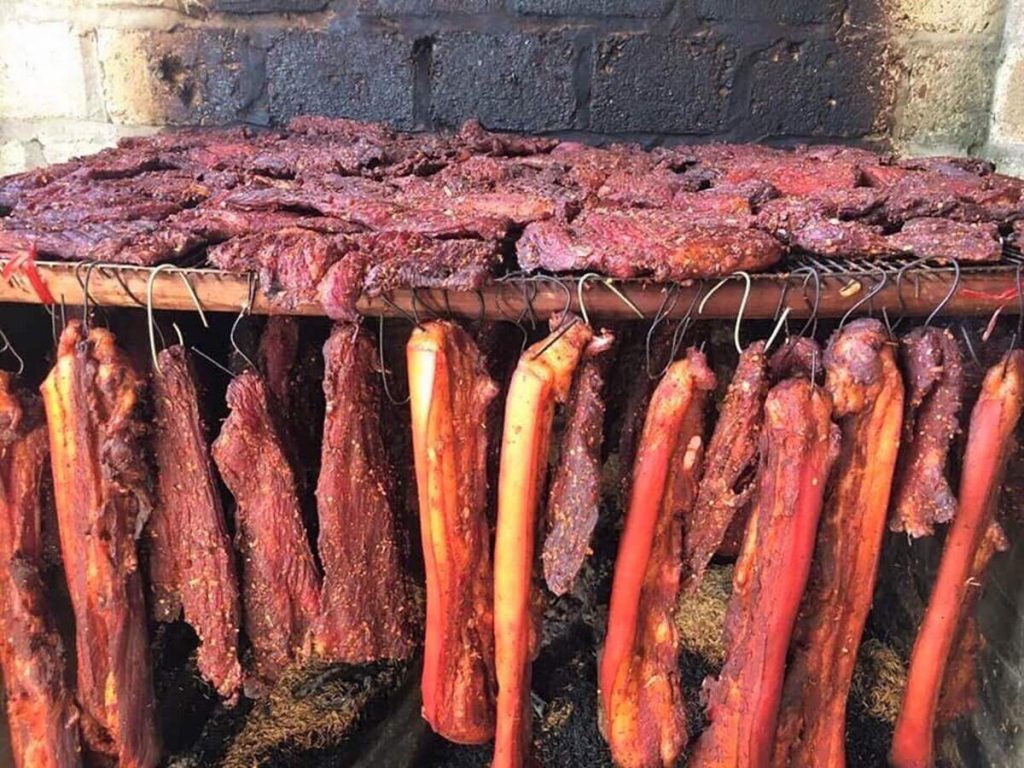
Buffalo and pig meat are cut into long strips, marinated with spices like chili, ginger, and mac khen, then skewered onto metal sticks and hung above the kitchen stove. The longer they hang, the drier the meat becomes, the firmer and smokier it gets, while retaining its characteristic delicious taste.
Buffalo and pig meat hung in the kitchen can be considered the most beloved dish for tourists when visiting Ha Giang. Many people who come here never forget to buy it as a gift for their family and friends. Thanks to this, it has become more widely known, becoming a fresh and delicious food for lowland tourists, as well as providing economic opportunities and employment for ethnic families.
Peppermint Honey
Dong Van peppermint honey is a product made by local farmers who take care of bees, harvest honey, and obtain the pure, distinct flavor of the rocky mountain region. Peppermint honey is sweet, nutritious, and provides stable economic value to the local population.
In the lunar months from September to December, peppermint flowers begin to bloom on the hills, mountainsides, and valleys, which is when the bees are busy collecting nectar. Peppermint is a wild plant that grows abundantly in the mountains and highlands, with bright and colorful flowers that attract bees. The name “peppermint honey” refers to the fact that bees compete to collect nectar from peppermint plants. Peppermint honey has many benefits for humans and is considered a tonic for various health conditions.
Free-range Pigs
Just the name alone makes people curious about what kind of pigs these are. These pigs are small and are usually carried under the arms when caught or purchased, which is why they are called “pigs under the armpit.” These pigs are raised freely from birth and are a traditional crossbreed between wild boars and Muong pigs. They feed on wild plants and vegetables in the forest and are occasionally given corn and cassava by humans.
The meat of free-range pigs is leaner than that of pigs raised in conventional ways. It can be used to prepare many delicious dishes. One special dish is grilled pork, marinated with distinctive spices like mac khen, dổi seeds, and moc mat, creating a flavor you will never forget.
Ha Giang Sour Pho
When mentioning a breakfast in this majestic rocky plateau, one cannot overlook sour pho. Pho chua, in fact, is not a specialty of Ha Giang, but it has been adapted to have its own unique taste.
Pho chua has its origins in China and spread to the northern border provinces: Ha Giang, Cao Bang, Bac Kan, Lang Son, etc. Pho chua, also known as “pho mat,” is a dish that is served mainly in the summer. In the past, pho chua was typically found in the menus of banquets. Nowadays, there are many marketplaces and vendors selling it, each with its own unique taste.
To have a delicious bowl of pho chua, fresh pho noodles are essential. People carefully choose and process rice grains to make soft, fragrant noodles. The process of making pho chua is simple, but achieving the perfect taste is quite challenging. The pho noodles are immersed in a vinegar and sugar mixture, mixed with cassava flour to make it sticky, and seasoned with various condiments. It should be boiled and stirred evenly. Accompaniments include thinly sliced grilled pork, crispy sausage, roast duck, garlic, fresh papaya, or cucumber slices soaked in the broth. While enjoying a bowl of pho, sipping corn wine in the morning is a perfect combination.
Lam Rice in Bac Me
Lam rice is cooked inside bamboo tubes and grilled over fire or hot coal. Ethnic people often bring lam rice with them when working in the fields as it is convenient and can be preserved well. Rice for lam rice is made from glutinous rice, soaked in water. Choosing fragrant and pliable rice grains is essential to make delicious lam rice. The preparation of lam rice is quite simple. Bamboo tubes are cleaned and dried, then rice is put into the tubes, with a bit of salt added before sealing and grilling on the fire for about an hour. This creates a delightful dish.
Ha Giang Wild Oranges
Ha Giang wild oranges are usually large with rough, dark, and spotty skin. When ripe, they have a beautiful yellow color, a sweet and refreshing taste, and a delightful aroma. These oranges are quite thick-skinned and resistant to spoilage. You can eat them directly or squeeze them for juice, and they are delicious either way.
Wild oranges are highly nutritious and also economically beneficial for the locals. They are renowned as a specialty product. Many people describe them as having a beautiful yellow color, bright red pulp, large segments, juiciness, and a distinctive fragrance.
Thang Co
Thang co is a specialty of the H’mong people. Although traditionally made with horse meat, it has now evolved to include beef, buffalo, and pork to suit various tastes. Cooking thang co is relatively simple, but to make it perfectly is a challenge. The organs of the horse are removed, cleaned thoroughly, and then cut into small pieces. They are marinated with spices, including salt, thao qua, dia dien, cinnamon, fragrant lime leaves, and roasted to release the fragrant aroma, then minced. Today, the taste may have changed slightly, but the way it is eaten remains the same, served in a communal pot on the stove. You scoop it up to eat, much like having hotpot.
Many people have thought for a long time that thang co is difficult to eat due to the smell of horse meat. But in reality, it’s the aroma of the spices marinated together with the meat that you’re sensing. Enjoying thang co while sipping corn wine is a delightful experience. This combination allows you to focus on the delicious sweet taste and the spicy kick of corn wine, making you want to eat more. Give this dish a try; you won’t be disappointed.
Buckwheat Cakes
In October and early November, Ha Giang is covered in the bloom of buckwheat flowers. Travelers flock here to admire the buckwheat fields. While most flowers look beautiful when they first bloom, the transition of buckwheat flowers from pure white to pale pink and deep red as they age is a unique sight to behold.
The seeds of buckwheat plants also contain specific nutrients and are the main ingredient in buckwheat cakes. After harvesting buckwheat seeds, they are dried and ground by hand. The entire process must be skillfully done to ensure the cake’s texture is smooth and not grainy. The ground dough is then kneaded with water and pressed into molds, then baked for about 15 minutes. Buckwheat cakes have a rich, hearty flavor. When visiting Ha Giang, be sure to try this special dish.
Buckwheat cakes come in two varieties: chewy or crispy, and both are delicious. You can buy either type as a gift for your family and friends.
Shan Tuyet Tea of Ancient Tea Trees
Not only does Ha Giang have diverse dishes, but it is also famous for various beverages, especially Shan Tuyet tea. Shan Tuyet tea plants grow at altitudes of thousands of meters in the Phìn Hò mountains, which provide a cool climate year-round. The tea in Phìn Hò is made from one bud and two young leaves picked from tea trees that are over 200 years old. The tea farming and processing do not involve any chemical substances. The taste of this tea is sweet and fragrant.
If you have tried this type of tea once, you will find it hard to forget its unique flavor. When savoring Shan Tuyet tea, take your time to enjoy it. The tea is not bitter; it has a slightly astringent taste. After drinking, a sweet aftertaste lingers in the throat, leaving a delicate and non-harsh sweetness.
Quan Ba Corn Wine with Mac Mat Leaves
Quan Ba corn wine, one of the most popular beverages. Corn is one of the main crops for the people of Ha Giang. That’s why the locals utilize this abundant supply of corn to create three corn-based products: men men (corn in earthenware jars), corn cakes, and corn wine. Corn wine is a famous specialty as well as a traditional cultural feature of Ha Giang.
Ha Giang’s topography is not suitable for farming, but the local people are as strong as iron and stone. Corn is sown in spring and grown on this land, so there is no need to worry about which kinds of plants the corn will have to overcome to develop well. After harvest, the corn is cooked, soaked, and then distilled for about 6 hours to produce fragrant, sweet, and slightly astringent corn wine.
What sets Ha Giang corn wine apart from those in other places is the use of men made from leaves in the distillation process. The leaves come from 30 different types of plants, and getting these leaves requires effort to climb the mountains to collect them. Therefore, the distiller’s hard work is repaid with jars of exceptionally fragrant and flavorful wine.
The article from DanangPrivateCar.com’s has provided a detailed introduction to the top delicious dishes to try in Ha Giang. We hope that these fundamental pieces of information will assist travelers in having a complete sightseeing trip. Ha Giang is always an appealing destination for every tourist. If you haven’t yet made plans for your trip, please refer to the article below for the most convenient journey.



